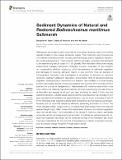Files in this item
Sediment dynamics of natural and restored Bolboschoenus maritimus saltmarsh
Item metadata
| dc.contributor.author | Taylor, Benjamin W. | |
| dc.contributor.author | Paterson, David M. | |
| dc.contributor.author | Baxter, John M. | |
| dc.date.accessioned | 2019-07-19T12:30:02Z | |
| dc.date.available | 2019-07-19T12:30:02Z | |
| dc.date.issued | 2019-06-26 | |
| dc.identifier | 259692226 | |
| dc.identifier | de8685fa-2693-4bb7-a4dc-b6baa6782f88 | |
| dc.identifier | 85068602006 | |
| dc.identifier | 000473143700001 | |
| dc.identifier.citation | Taylor , B W , Paterson , D M & Baxter , J M 2019 , ' Sediment dynamics of natural and restored Bolboschoenus maritimus saltmarsh ' , Frontiers in Ecology and Evolution , vol. 7 , 237 . https://doi.org/10.3389/fevo.2019.00237 | en |
| dc.identifier.issn | 2296-701X | |
| dc.identifier.other | ORCID: /0000-0003-1174-6476/work/59698724 | |
| dc.identifier.uri | https://hdl.handle.net/10023/18136 | |
| dc.description | The authors received funding from the MASTS pooling initiative (The Marine Alliance for Science and Technology for Scotland) and Scottish Natural Heritage (SNH), their support is gratefully acknowledged. MASTS is funded by the Scottish Funding Council (grant reference HR09011) and contributing institutions. | en |
| dc.description.abstract | Saltmarshes are biogeomorphic ecosystems comprising halophytic plant communities typically located on low energy temperate coasts. Their distribution and structure are controlled by several key drivers, including sediment supply, type of vegetation, elevation, and local hydrodynamics. These dynamic systems are highly vulnerable and estimated to be experiencing annual losses of 1–2% globally. Past restoration efforts have largely implemented managed realignment strategies, however, examples of, and research on, conservation initiatives employing direct transplantation of saltmarsh vegetation into damaged or receding saltmarsh stands is less common. Here an example of transplantation restoration was investigated to understand its influence on sediment dynamics. Sediment settlement, deposition, and accretion rates of natural and restored vegetation (Bolboschoenus maritimus) and adjacent bare mudflats in a small estuary system were studied across consecutive seasons from summer 2015 to spring 2016 to examine the success of transplantation. Natural areas of B. maritimus were shown to be most effective at retaining deposited material, although experiencing the least amount of deposition (an average of 48 g/m2 per day), accreting by nearly 7.5 mm over the experimental period. Mudflat areas experienced the most deposition (an average of 322 g/m2 per day) whilst exhibiting the greatest erosion over the study, a decrease in level of 6 mm. Restored areas experience similar rates of deposition as their natural counterparts, however, did not retain this material as efficiently, presenting an erosion of 1.6 mm. The study indicates certain biogeomorphic processes have been altered within the restored area and beginning to reflect those of the natural area. However, the restored vegetation does not yet fully match the functionality of the natural B. maritimus stand, specifically where the natural stand displayed a net accretion of material the restored area did not. Such discrepancies may impact on the continued survival of the restoration site, which may have implications for the potential of transplanting to deliver ecosystem services, such as climate change mitigation through carbon burial. | |
| dc.format.extent | 10 | |
| dc.format.extent | 792574 | |
| dc.language.iso | eng | |
| dc.relation.ispartof | Frontiers in Ecology and Evolution | en |
| dc.subject | Accretion | en |
| dc.subject | Restoration | en |
| dc.subject | Saltmarsh | en |
| dc.subject | Seasonal | en |
| dc.subject | Sediment deposition | en |
| dc.subject | QH301 Biology | en |
| dc.subject | Ecology, Evolution, Behavior and Systematics | en |
| dc.subject | Ecology | en |
| dc.subject | NDAS | en |
| dc.subject | SDG 13 - Climate Action | en |
| dc.subject.lcc | QH301 | en |
| dc.title | Sediment dynamics of natural and restored Bolboschoenus maritimus saltmarsh | en |
| dc.type | Journal article | en |
| dc.contributor.institution | University of St Andrews. Sediment Ecology Research Group | en |
| dc.contributor.institution | University of St Andrews. School of Biology | en |
| dc.contributor.institution | University of St Andrews. Scottish Oceans Institute | en |
| dc.contributor.institution | University of St Andrews. St Andrews Sustainability Institute | en |
| dc.contributor.institution | University of St Andrews. Marine Alliance for Science & Technology Scotland | en |
| dc.identifier.doi | 10.3389/fevo.2019.00237 | |
| dc.description.status | Peer reviewed | en |
This item appears in the following Collection(s)
Items in the St Andrews Research Repository are protected by copyright, with all rights reserved, unless otherwise indicated.

